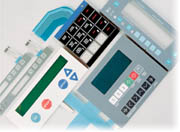PSAs: The Foundation of Membrane Switch Success

From the control pad on a microwave to the remote control for a hospital bed, membrane switches can be found everywhere in our day-to-day lives. Membrane switches, a multi-layered construction including conductive, dielectric and adhesive polymers, are essential to the performance of any product. As is their role, membrane switches endure thousands, if not millions, of actuations during their life spans. The switch is only as good as its components, and pressure-sensitive adhesives (PSA) play a crucial role in ensuring component success. PSAs offer custom capabilities suited to the varying details within each membrane switch design. Given the importance of the membrane switch to overall product functionality, understanding application criteria and conditions is indispensable, and ensures the creation of a reliable, long-term membrane switch.
Membrane Switch Types
There are three basic membrane switch design types: flat, metal dome and poly dome. Each switch design possesses certain attributes that make them attractive for particular applications.Flat membrane switches are often used for keyboards where tactile response is not required. This switch design is particularly resistant to harsh environmental conditions, such as exposure to chemicals. As this design is also less complex in nature, it tends to be less expensive than other switch types.
Metal dome and poly dome membrane switches, by contrast, use a dome to provide a physical, tactile reaction for the switch operator. The dome is an actual functioning part of the working circuit where, when pressed, a circuit is completed. Metal dome membrane switches provide long-term performance but may not perform as well when used with flexible circuitry. Poly dome membrane switches are easier to assemble than metal dome switches, and are therefore also less expensive.
Regardless of whether you are constructing a flat, metal dome or poly dome membrane switch, PSAs are integral to their ultimate success. PSAs enable membrane switches to survive a range of grueling conditions, withstanding moisture, boiling fluids and harsh chemicals, by literally holding the sandwich of switch components together.
Membrane Switch Construction and Adhesive Reliability
As mentioned, the membrane switch is a multi-layered construction. First, a double-faced adhesive or laminating adhesive system is used to adhere the sub-surface printed graphic overlay to the top circuit. The adhesive system allows the switch manufacturer to adhere the back of the graphic overlay to the top of the upper circuit carrier, providing a decorative metallic background to the unprinted clear areas of the graphic overlay. Here, the built-in elasticity of the PSA provides the superior bond retention required to endure thousands of switch actuations without delaminating. Further, the PSA is able to endure chemical exposure, heat exposure and humidity while providing excellent resistance to shear stress.The next layer, the spacer component, both separates and holds together the upper and lower circuit layers. The spacer material is often a polyester film PSA-coated on both sides. Some pressure-sensitive suppliers can also provide a polycarbonate film, another spacer material alternative that is growing in use. The use of pressure-sensitive materials offers flexibility in total spacer thickness, which is beneficial in meeting various application requirements.
Finally, the completed membrane switch must be adhered to a rigid backer board or to the equipment that the switch will activate. Pressure-sensitive double-faced and laminating adhesive mounting systems can be used for this purpose. A variety of double-faced polyesters and polycarbonates, ranging from 1 mil to 30 mil, can be coated on both sides with either a standard or custom PSA.
When completely assembled and connected to the instrument or appliance, the sealed construction of the membrane switch prevents the entrapment of foreign particles, including dust and bacteria. In addition, the membrane switch is able to resist powerful cleaners, disinfectants and solvents. Because membrane switches are thin constructions that are thoroughly sealed, they offer space savings, easy cleaning, and the ability to incorporate appealing graphics.

The PSA Advantage
PSAs offer several performance characteristics that have made them popular with membrane switch designers. Specifically, there are four primary areas where pressure-sensitive adhesives prove their mettle: compatibility, durability, repositionability and flexibility.Compatibility
The adhesive must be compatible with a variety of switching mechanics, such as poly domes, metallic domes and flat switches, and must bond well to a host of surfaces including printed circuit boards, surface metals, print-treated and untreated polyester, polycarbonate and other plastics. The very configuration of a membrane switch means that there is a limited switch area that can be dedicated to the adhesive; therefore it is crucial that the PSA bond securely within a limited amount of space. In addition, the adhesive must be compatible with a variety of dielectric, decorative and conductive inks.
Adhesive compatibility is particularly crucial in terms of the graphic overlay. Membrane switch failure may occur when UV inks are used in conjunction with acrylic adhesive systems to produce the graphic overlay layer of a switch. Over time, a reaction can take place between the UV inks and the adhesive that causes the membrane switch to delaminate, and, ultimately, fail. However, the adhesive can be specifically engineered to prevent such a reaction without reducing the adhesive's elasticity.
Durability
The stress imparted on a PSA during dome actuation requires a high-shear adhesive with exceptional cohesive strength. High-performance PSAs offer a level of elasticity that promotes superior bond retention as the switch cycles through thousands of actuations.
The PSA must also resist heat, moisture and exposure to chemicals, especially when being used as a component in medical equipment. Here again, custom PSAs are able to meet this specific application requirement.
Repositionability
Switch manufacturers require a product that can be repositioned within the first few minutes of application. This prevents scrapping an expensive switch component and therefore reduces waste. It is also crucial that the tack of the adhesive remain consistent from lot to lot to ensure repositionability that gives way to permanent adhesion after a set amount of time.
Flexibility
While certain membrane switch requirements are universal, each switch application has at least one unique requirement. Therefore, the ability to mix and match different PSA characteristics is important to meet the specific needs of the application.
High-performance acrylic adhesives, in particular, can be customized to meet industry standards. In some cases, a switch application may have to meet an industry standard such as Underwriter Laboratories' UL 746C (for polymeric adhesive systems, electrical equipment recognition) or ASTM F 1578-00 (a standard test of an adhesive's mechanical properties). These objective standards provide good measures of an adhesive in terms of its reliability.
Application Success
Functionality of the membrane switch relies heavily on the selection and performance of its components. The use of PSAs within the multi-layered construction ensures application success. Design of the switch, component materials, application and environmental conditions, as well as specific switch requirements, are important considerations that impact the end result. With the flexibility and conformability characteristics of PSAs, switch manufacturers can create a membrane switch with long-term reliability for overall product performance.For more information, contact Chris Drury at (508) 885-8253 or e-mail cdrury@FLEXcon.com .
Looking for a reprint of this article?
From high-res PDFs to custom plaques, order your copy today!







